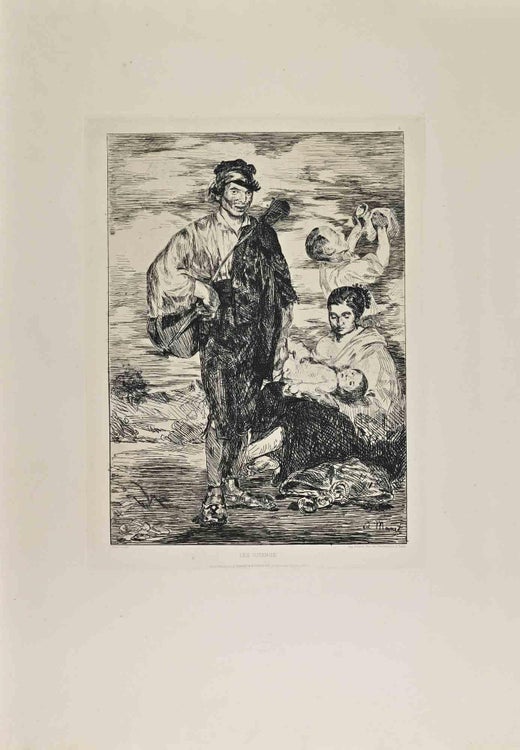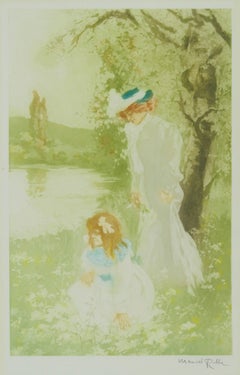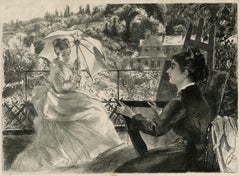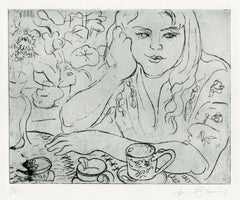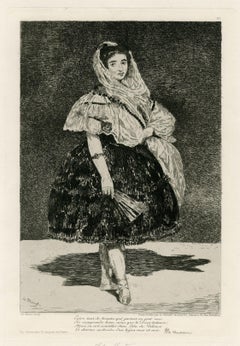Want more images or videos?
Request additional images or videos from the seller
1 of 8
Édouard ManetLe Gamin (The Kid)1862
1862
$2,400List Price
About the Item
- Creator:Édouard Manet (1832 - 1883, French)
- Creation Year:1862
- Dimensions:Height: 8 in (20.32 cm)Width: 5.69 in (14.46 cm)
- Medium:
- Movement & Style:
- Period:
- Condition:
- Gallery Location:Fairlawn, OH
- Reference Number:Seller: FA112771stDibs: LU14013075192
Édouard Manet
Edouard Manet (1832 – 1883) was a French painter. He was one of the first 19th-century artists to paint modern life, and a pivotal figure in the transition from Realism to Impressionism. Born into an upper-class household with strong political connections, Manet rejected the future originally envisioned for him, and became engrossed in the world of painting. His early masterworks, The Luncheon on the Grass (Le déjeuner sur l'herbe) and Olympia, both 1863, caused great controversy and served as rallying points for the young painters who would create Impressionism. Today, these are considered watershed paintings that mark the start of modern art. The last 20 years of Manet's life saw him form bonds with other great artists of the time, and develop his own style that would be heralded as innovative and serve as a major influence for future painters. Although harshly condemned by critics who decried its lack of conventional finish, Manet's work had admirers from the beginning. One was Emile Zola, who wrote in 1867: "We are not accustomed to seeing such simple and direct translations of reality. Then, as I said, there is such a surprisingly elegant awkwardness ... it is a truly charming experience to contemplate this luminous and serious painting which interprets nature with a gentle brutality."
About the Seller
5.0
Recognized Seller
These prestigious sellers are industry leaders and represent the highest echelon for item quality and design.
Gold Seller
Premium sellers maintaining a 4.3+ rating and 24-hour response times
Established in 1978
1stDibs seller since 2013
834 sales on 1stDibs
Associations
International Fine Print Dealers Association
Authenticity Guarantee
In the unlikely event there’s an issue with an item’s authenticity, contact us within 1 year for a full refund. DetailsMoney-Back Guarantee
If your item is not as described, is damaged in transit, or does not arrive, contact us within 7 days for a full refund. Details24-Hour Cancellation
You have a 24-hour grace period in which to reconsider your purchase, with no questions asked.Vetted Professional Sellers
Our world-class sellers must adhere to strict standards for service and quality, maintaining the integrity of our listings.Price-Match Guarantee
If you find that a seller listed the same item for a lower price elsewhere, we’ll match it.Trusted Global Delivery
Our best-in-class carrier network provides specialized shipping options worldwide, including custom delivery.You May Also Like
Minne Playing with a Cat (Minne Jouant avec un Chat)
By Jacques Villon
Located in New York, NY
Jacques Villon (1875-1963) etching, aquatint, and drypoint, Minne Playing with a Cat (Minne Jouant avec un Chat),1907, signed in pencil and numbered (12/30)(Ginestet and Pouillon 192...
Category
Early 1900s Impressionist Figurative Prints
Materials
Drypoint, Etching, Aquatint
La Parisienne (tournee a gauche, petite planche)
By Jacques Villon
Located in New York, NY
Jacques Villon (1875-1963), La Parisienne (tournee a gauche, petite planche), 1904, etching and aquatint in color (black, brown, red), signed and dated...
Category
Early 1900s Impressionist Figurative Prints
Materials
Etching, Aquatint
Pour le Bapteme de Madeleine
By Jacques Villon
Located in New York, NY
Jacques Villon (1875-1963), Pour le Bapteme de Madeleine, 1900, aquatint , etching, printed in soft blue ink, signed in pencil lower right and numbered 7/10. On laid paper. Reference...
Category
Early 1900s Impressionist Figurative Prints
Materials
Etching, Aquatint
La Parisienne, (tournee a gauche, petite planche)
By Jacques Villon
Located in New York, NY
Jacques Villon (1875-1963), La Parisienne, (tournee a gauche, petite planche), 1904, etching, roulette and aquatint, signed in pencil [also signed in pla...
Category
Early 1900s Impressionist Figurative Prints
Materials
Etching, Aquatint
The Beggars
By James Abbott McNeill Whistler
Located in New York, NY
James Whistler (1834-1903), The Beggars, etching and drypoint, 1879-80, signed with the butterfly and inscribed “imp”. Reference: Glasgow 190, seventh sta...
Category
1870s Impressionist Figurative Prints
Materials
Drypoint, Etching
Early 20th Century Miniature Etching, Portrait of an Old Woman by Ralph Sweet
Located in Soquel, CA
Early 20th Century Miniature Etching, Portrait of an Old Woman by Ralph Sweet
Compelling early 20th century small-scale figurative etching of an old...
Category
Early 20th Century American Impressionist Portrait Prints
Materials
Paper, Etching
$700 Sale Price
20% Off
H 7.25 in W 5.5 in D 0.25 in
Pomegranates
By Kaiko Moti
Located in San Francisco, CA
This artwork titled "Pomegranates" c.1970 is an original color aquatint on Japan paper by noted Indian artist Kaiko Moti, 1921-1989. It is hand signed and numbered XXII/LXXV in White pencil by the artist. The Size is 22 x 29.25 inches. Printed to the edge. It is in excellent condition, some hanging tape remaining on the back from a previous framing.
About the artist:
Born (Kaikobad Motiwalla) in Bombay, India on December 15, 1921, Moti was first educated at the Bombay School of Fine Arts but his talent led him onwards to study at the University College in London (on scholarship) and at the Slade School of Fine Arts, London, where he received a Master's degree in Painting and Sculpture. While still in London he studied under MacWilliam and Reginald Butler.
Eventually moving to Paris in 1950, Moti attended the Academie de la Grand Chaumiere, Atelier Zadkine, to pursue his love of sculpture but lack of space soon compelled him to turn his attention to working on copper plates and he studied engraving with William Stanley Hayter...
Category
Mid-20th Century Impressionist Still-life Prints
Materials
Aquatint
Baigneuse debout à mi-jambes
By Pierre Auguste Renoir
Located in Santa Monica, CA
PIERRE-AUGUSTE RENOIR (French, 1841 - 1919)
BAIGNEUSE DEBOUT A MI JAMBES (D., S. 23)
Etching, 1910, a later impression on laid paper, the only state. Full margins with deckle edge...
Category
1910s Impressionist Figurative Prints
Materials
Etching
Billingsgate
By James Abbott McNeill Whistler
Located in Middletown, NY
Etching printed in dark brownish black ink on cream laid paper, 6 x 8 7/8 inches (152 x 226 mm); full margins. Extremely minor and unobtrusive band of toning along the top sheet edg...
Category
Mid-19th Century Impressionist Landscape Prints
Materials
Laid Paper, Drypoint, Etching
Becquet
By James Abbott McNeill Whistler
Located in Storrs, CT
J. Becquet, Sculptor (The Fiddler). 1859. Drypoint. Kennedy 52 state iv; Glasgow 62. state i. 10 1/8 x 7 1/2 (sheet 15 5/16 x 9 3/4). Series: "Sixteen Etchings or Scenes on the Thame...
Category
Mid-19th Century American Impressionist Figurative Prints
Materials
Drypoint, Etching
More From This Seller
View AllAvril
By Manuel Robbe
Located in Fairlawn, OH
Avril (April)
Color aquatint and etching, c. 1906
Signed in pencil lower right
Edition: c. 100
Excellent impression, fresh colors
Reference: Merrill Chase Volume 1, No. 9
Condition: ...
Category
Early 1900s Impressionist Figurative Prints
Materials
Aquatint
La Terrasse de la Villa Brancas, Sevres (The Terrace of the Villa Brancas)
By Félix Bracquemond
Located in Fairlawn, OH
La Terrasse de la Villa Brancas, Sevres (The Terrace of the Villa Brancas)
etching & drypoint, 1876
Signed in the plate bottom right corner (see photo)
in plate, at lower left: xbre ...
Category
1870s Impressionist Figurative Prints
Materials
Etching
Daureen, II
By Nell Blaine
Located in Fairlawn, OH
Daureen, II
Etching, 1969
Signed in pencil lower right
Edition: 28 (17/28)
Condition: Excellent
Two hinges from previous matting
Blaine studied etching at Atelier 17 in New York and considered one of their distinguished alums.
"Blaine was foremost an abstract painter, first a student of Theresa Pollak...
Category
1960s Impressionist Figurative Prints
Materials
Etching
Lola De Valence
By Édouard Manet
Located in Fairlawn, OH
Lola De Valence
Etching, 1862
Signed in the plate lower left: “Ed Manet”
Printed on chine collee paper, without watermark
From the first edition, published by Cadart and Luquet, Paris, before the removal of the inscription “ Ed. Manet sculpt”
From the 1863 edition, before the 1874 Portfolio, 1890 Portolio. 1894 Dumont edition and the Strolin edition of 100 in 1905
Pencil inscription with title below the plate in the lower margin
Conditiono: Excellent
Image size: 10 7/8 x 6 7/8 inches
Plate size: 18 3/4 x 13 inches
Reference: Harris-Manet 33 iii/III
Guerin-Manet 23 vi/VIII
The painting that this etching is inspired by is in the collection of the Musee d'Orsay, Paris.
"Lola de Valence is a painting by the painter Édouard Manet in 1862 . The canvas represents a dancer dressed intraditional Spanish clothes...
Category
1860s Impressionist Figurative Prints
Materials
Etching
Au bord de la mer (At the Sea Side)
By James Jacques Joseph Tissot
Located in Fairlawn, OH
Au bord de la mer (At the Sea Side)
Etching and drypoint, 1880
Signed in the plate middle left edge (see photo)
Edition: c. 100
A very rich impression, full of burr and contrasts
Pri...
Category
1880s Impressionist Figurative Prints
Materials
Etching
L'enfant prodigue: en pays etranger (The Prodigal Son: In Foreign Climes)
By James Jacques Joseph Tissot
Located in Fairlawn, OH
L'enfant prodigue: en pays etranger (The Prodigal Son: In Foreign Climes)
Etching, 1881
Unsigned (as usual for this state)
From: L'enfant prodigue, (The Prodigal Son, five plates)
Ed...
Category
1880s Impressionist Figurative Prints
Materials
Etching
Still Thinking About These?
All Recently ViewedMore Ways To Browse
Andrew Wyeth Signed And Numbered Prints
Andy Warhol Electric Chairs
Ben Shahn Martin Luther King
Bus Stop Sign
Cain And Abel
Calder Behind The Mirror
Corneille On Sale
Cundo Bermudez
Dali Death
Dali Flowers
Dali Hell
Dali Ronsard
Deux Femmes Nues
Enrico Baj On Sale
Feliks Topolski
Francois Gilot
George Soper
Isabel Rawsthorne
